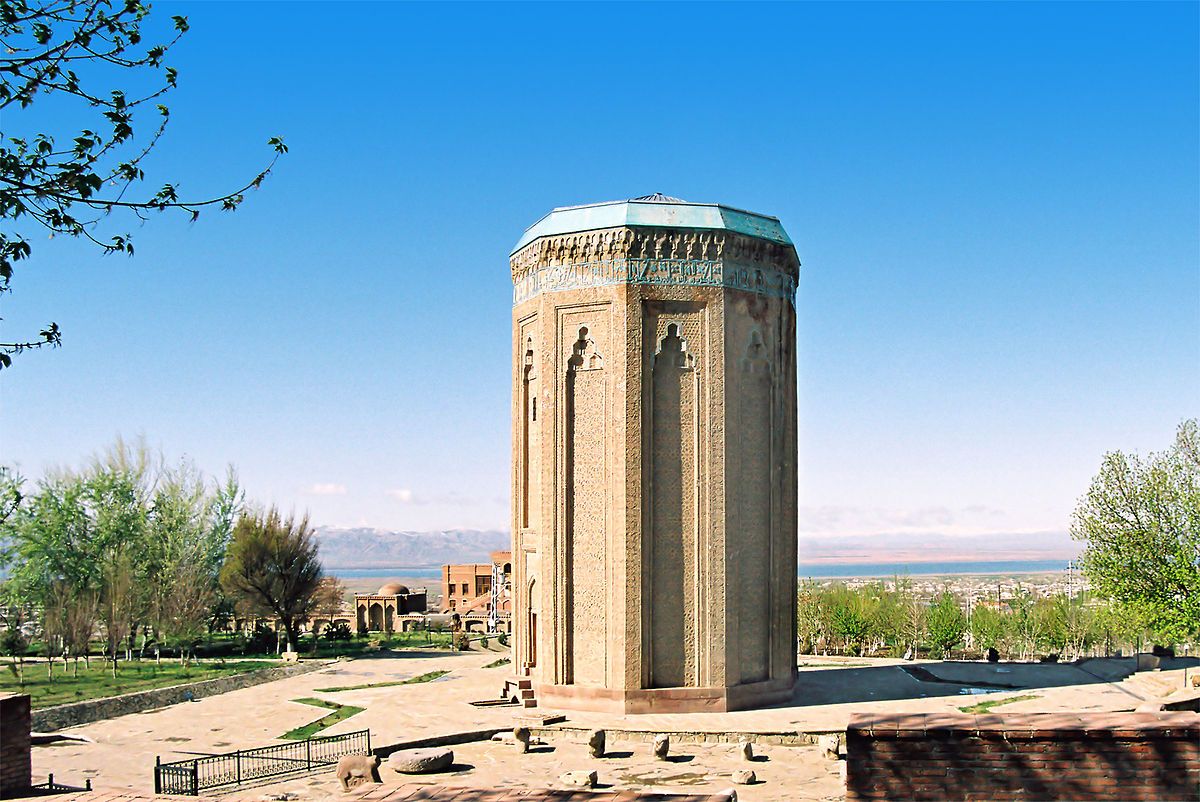The eye of Nakhchivan: Momina Khatun Tomb as a symbol of feminine sublimity

By Susanbar Aghamaliyeva
The Momina Xatun Tomb is a symbol of feminine sublimity in the XII century in Azerbaijan and is described as one of the pearls of Eastern architecture. It was built by architect Ajami Abubakir oglu Nakhchivan in 1186.
Shamsaddin Eldaniz, the founder of Azerbaijan the Atabay state, decided to erect a tomb on the grave of his wife Momina Khatun, and Mahammad Jahan Pahlavan, son of Shamsaddin Eldaniz, completed its construction. Local people remember this monument as Atabay Tomb. The monument contains these words in Cufic writing: “After us but is left wind. After our death, our work remains as present.”
The height of the tomb was thirty-four meters, but later its outer cover of eight meters was destroyed. The tomb consists of underground (vault) and overground parts. In accordance with the project, the vault part is made up of 10 shapes. Researchers believe that Shamsaddin Eldaniz, ruler of Atabaylar state, his wife Momina Khatun, and their son Mahammad Jahan Pahlavan, were buried in the vault that had been robbed by Armenian scholars during archaeological activities in Soviet time.
In 2003, the precious stone of the tomb was neatly restored. The vault with the original structure possesses a rich design arrangement. The column in the center joins with each corner of the decagon in a spanned form. This structure in the vault was later implemented in the west in gothic architecture. The overground part of the tomb is a decagon (surrounded by Cunic inspirations on either side) but inside it is round-shaped. There are four rounded lockets where the names of caliphs inside the dome are inscribed.
The corners of the Momina Khatun Tomb, built of burnt bricks, were completed with projection forms with surfaces in a hollow form. The corner projections of the tomb were covered with inscriptions written in Cufic. The length of these inscriptions reaches 500 meters as well. The tomb surface structure was designed with turquoise glazed tiles consisting of geometrical ornaments and had been enriched widely. The part of the tomb is different in its design features. At this point, the surface has been divided into two parts down the entrance door in a span form, but the upper part was completed with ornamental designs.
The inscriptions showing the name of the architect and the date of tomb construction were engraved in the upper part of the headspan. The simple system inside the surface of the tomb was plastered with clay and the dome was decorated with designs of four medallions. For its compositions, perfectness, neatness of separations, being worked neatly, and architectural solution the tomb is considered one of the architectural masterpieces of the Middle Ages.
M. V. Alpatov, a popular historian of art, writes that “the tomb of Momina Khatun erected in the XII century in Nakhchivan by the Azerbaijan masters is a monument of rare beauty and neatness. The Momina Khatun Tomb is eternal as the most magnificent classic works, like the “Shahnama” of Firdovsi, and “Leyli and Majnun” by Nizami. Alpatov is confident that it is impossible to find such a beautiful monument in European architecture of that time. Together with its grandiose architectural richness, the monument demonstrates the ancient history of Azerbaijan. Its mighty state represents a high-level culture and great architectural school of Azerbaijan.
The young generations also enjoy the eye of Nakhchivan – the Momina Khatun Tomb as a symbol of feminine sublimity and pride of ancestors as well. This monument attracts many tourists to Naxcivan and increases the number of them year by year as the Naxcivan State Statistical Committee said. As a saying goes - learn your past to survive in the future.
---
Follow us on Twitter @AzerNewsAz
Here we are to serve you with news right now. It does not cost much, but worth your attention.
Choose to support open, independent, quality journalism and subscribe on a monthly basis.
By subscribing to our online newspaper, you can have full digital access to all news, analysis, and much more.
You can also follow AzerNEWS on Twitter @AzerNewsAz or Facebook @AzerNewsNewspaper
Thank you!
